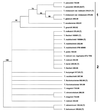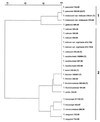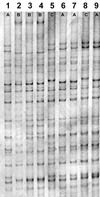Molecular taxonomy of the Trichophyton rubrum complex
- PMID: 10970379
- PMCID: PMC87382
- DOI: 10.1128/JCM.38.9.3329-3336.2000
Molecular taxonomy of the Trichophyton rubrum complex
Abstract
The validity of taxa around Trichophyton rubrum was evaluated by a combination of phenetic and molecular methods. Morphological and physiological features were compared to results of sequencing of the internal transcribed spacer region of the ribosomal operon, PCR fingerprinting, and amplified fragment length polymorphism analysis. The 15 species and varieties investigated (Trichophyton circonvolutum, Trichophyton fischeri, Trichophyton fluviomuniense, Trichophyton glabrum, Trichophyton gourvilii, Trichophyton kanei, Trichophyton kuryangei, Trichophyton megninii, Trichophyton pedis, Trichophyton raubitschekii, Trichophyton rodhaini, Trichophyton rubrum var. nigricans, Trichophyton soudanense, Trichophyton violaceum var. indicum, and Trichophyton yaoundei) were reclassified or synonymized as T. rubrum or T. violaceum.
Figures




References
-
- Agostini A. Una nuova specie di Bodinia causa di tigna umana nell'Eritrea. Atti Ist Bot Univ Pavia. 1930;II:118–125.
-
- Ajello L. A taxonomic review of the dermatophytes and related species. Sabouraudia. 1968;6:147–159. - PubMed
-
- Baer R L, Rosenthal S A, Furnari D. Survival of dermatophytes applied on the feet. J Invest Dermatol. 1955;24:619–662. - PubMed
-
- Blanchard R. Parasites vegetaux à l'exclusion des bacteries. In C. Bouchard, Traité de pathologie génerale vol. 2. Paris, France: Masson et Cie; 1896. pp. 811–926.
Publication types
MeSH terms
Substances
LinkOut - more resources
Full Text Sources
Other Literature Sources
Medical

